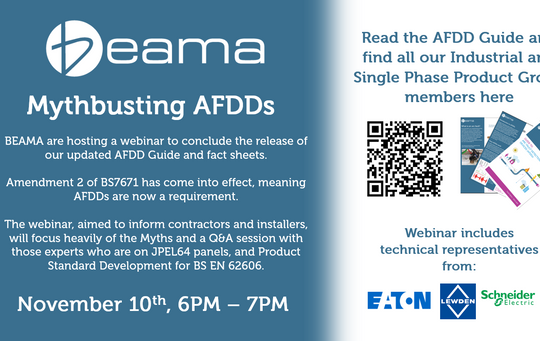BEAMA guides and fact sheets to Arc Fault Detection Devices (AFDDs)
The release of Amendment 2 to the 18th Edition Wiring regulations has introduced the requirement to use AFDDs (Arc Fault Detection Devices) for some socket-outlet circuits in certain type of premises.

BEAMA has produced a number of guides, fact sheets and FAQs on AFDDs and their uses.
To support the industry in implementing the requirements of Amendment 2 of the 18th Edition, BEAMA has published a Guide to AFDDs, a series of fact sheets and a comprehensive FAQ list.
With the use of AFDDs being a new requirement, installers and specifiers will no doubt have some questions on AFDDs as these devices may be new to some.
An arcing fault is an unintentional arcing condition in a circuit. Arcing creates high intensity heating at the point of the arc resulting in burning particles that can over time ignite surrounding material. Repeated arcing can create carbon paths that are the foundation for continued arcing, generating even higher temperatures. The temperatures of these arcs can exceed 6000 °C.
AFDDs provide important additional protection against fire that other protection devices cannot. A major change in IET Wiring Regulations, BS 7671: 2018+A2:2022, is that the use of AFDDs has become mandatory for some socket-outlet circuits in certain types of premises, and recommended in all other types of premises for the prescribed socket-outlet circuits.
The BEAMA publications on AFDDs intend to inform and enlighten members of the industry on this technology and its functions.
To mark the release of the updated AFDD Guide and associated facts sheets BEAMA hosted a webinar joined by some of the members of the ISPPG group to discuss AFDDs.
Since the inclusion of Arc Fault Detection Devices within BS 7671 in the 17th Edition and now 18th edition there has been a lot of negative press, misunderstanding, misconception and in some cases false claims made about the technology. This webinar aimed to educate the supply chain, designers and specifiers on this potentially life saving device. The focus was heavily on the Myths and a Q&A session with those experts who are on JPEL64 panels, and Product Standard Development for BS EN 62606.

